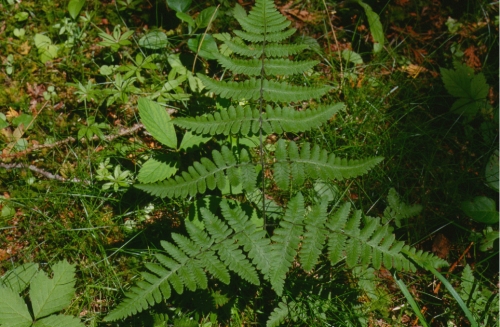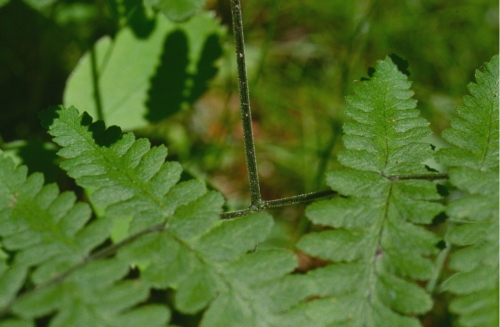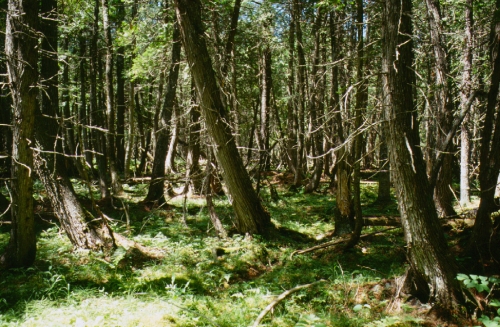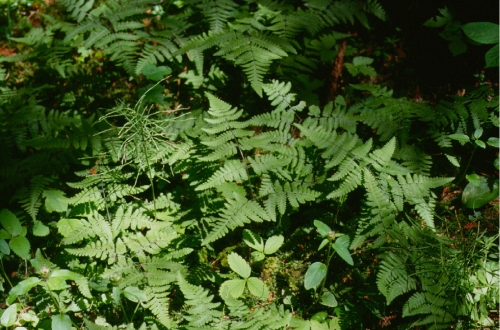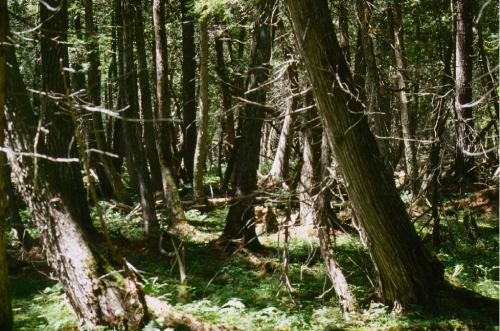Plants and Animals
Gymnocarpium robertianum Limestone oak fern
Key Characteristics
Small fern (10-50 cm) of dense cedar swamps and limestone outcroppings; leaf broadly triangular, twice-divided, pinnae straight, perpendicular to rachis; underside of leaf and rachis densely covered by short, glandular hairs.
Status and Rank
US Status: No Status/Not Listed
State Status: T - Threatened (legally protected)
Global Rank: G5 - Secure
State Rank: S2 - Imperiled
Occurrences
| County | Number of Occurrences | Year Last Observed |
|---|---|---|
| Charlevoix | 1 | 2001 |
| Cheboygan | 1 | 1948 |
| Chippewa | 5 | 2022 |
| Delta | 3 | 1989 |
| Emmet | 1 | 2002 |
| Mackinac | 9 | 2023 |
| Marquette | 1 | 2016 |
| Menominee | 1 | 2024 |
| Montmorency | 2 | 1998 |
| St. Clair | 1 | 1888 |
Information is summarized from MNFI's database of rare species and community occurrences. Data may not reflect true distribution since much of the state has not been thoroughly surveyed.
Habitat
This species is found primiarly in northern white cedar-dominated swamps in northern Lower Michigan and the Upper Peninsula, but can also occur in shaded, cedar-dominated limestone glades and shaded limestone cliffs.
Natural Community Types
- Boreal forest
- Limestone bedrock glade
- Limestone lakeshore cliff
- Mesic northern forest
- Rich conifer swamp
- Wooded dune and swale complex
For each species, lists of natural communities were derived from review of the nearly 6,500 element occurrences in the MNFI database, in addition to herbarium label data for some taxa. In most cases, at least one specimen record exists for each listed natural community. For certain taxa, especially poorly collected or extirpated species of prairie and savanna habitats, natural community lists were derived from inferences from collection sites and habitat preferences in immediately adjacent states (particularly Indiana and Illinois). Natural communities are not listed for those species documented only from altered or ruderal habitats in Michigan, especially for taxa that occur in a variety of habitats outside of the state.
Natural communities are not listed in order of frequency of occurrence, but are rather derived from the full set of natural communities, organized by Ecological Group. In many cases, the general habitat descriptions should provide greater clarity and direction to the surveyor. In future versions of the Rare Species Explorer, we hope to incorporate natural community fidelity ranks for each taxon.
Associated Plants
Abies balsamea (balsam fir), Aquilegia canadensis (wild columbine), Aralia nudicaulis (wild sarsaparilla), Asplenium ruta-muraria (wall-rue), A. trichomanes (maidenhair spleenwort), Betula papyrifera (paper birch), Campanula rotundifolia (harebell), Carex eburnea, C. pedunculata, Clintonia borealis (bluebead-lily), Coptis trifolia (goldthread), Cornus canadensis (bunchberry), Cornus rugosa (round-leaved dogwood), Cypripedium parviflorum var. pubescens (large yellow lady-slipper), Cystopteris fragilis (fragile fern), Diervilla lonicera (bush-honeysuckle), Fragaria virginiana (wild strawberry), Galium triflorum (fragrant bedstraw), Gymnocarpium dryopteris (oak fern), Halenia deflexa (spurred gentian), Huperzia lucidula (shining clubmoss), Linnaea borealis (twinflower), Maianthemum canadense (Canada mayflower), Mitella nuda (naked miterwort), Osmunda regalis (royal fern), Pellaea glabella (smooth cliff-brake), Petasites frigidus (sweet-coltsfoot), Polygala paucifolia (gay-wings), Populus tremuloides (quaking aspen), Ribes americanum (wild black currant), Rubus pubescens (dwarf raspberry), Shepherdia canadensis (soapberry), Sphagnum spp. (sphagnum mosses), Thuja occidentalis (northern white-cedar), Trientalis borealis (star-flower), Viola renifolia (kidney-leaved violet).
Management Recommendations
This species requires the maintenance of hydrology in conifer swamps and protection of groundwater sources. Maintenance of the forest canopy is also likely important to provide continued shade and a cool, moist microclimate.
Survey Methods
Random meander search covers areas that appear likely to have rare taxa, based on habitat and the judgement of the investigator.
-
Meander search
-
Survey Period: From third week of June to third week of September
-
References
Survey References
- Elzinga, C.L., D.W. Salzer, and J.W. Willoughby. 1998. Measuring and Monitoring Plant Populations. The Nature Conservancy and Bureau of Land Management, Denver. BLM Technical Reference 1730-1. 477pp.
- Goff, G.F., G.A. Dawson, and J.J. Rochow. 1982. Site examination for Threatened and Endangered plant species. Environmental Management 6(4): 307-316
- Nelson, J.R. 1984. Rare Plant Field Survey Guidelines. In: J.P. Smith and R. York. Inventory of rare and endangered vascular plants of California. 3rd Ed. California Native Plant Society, Berkeley. 174pp.
- Nelson, J.R. 1986. Rare Plant Surveys: Techniques For Impact Assessment. Natural Areas Journal 5(3):18-30.
- Nelson, J.R. 1987. Rare Plant Surveys: Techniques for Impact Assessment. In: Conservation and management of rare and endangered plants. Ed. T.S. Elias. California Native Plant Society, Sacramento. 8pp.
Technical References
- Billington, C. 1952. Ferns of Michigan. Cranbrook Institute of Science Bulliten 32. 240pp.
- Cody, W.J. and D.M. Britton. 1989. Ferns and fern allies of Canada. Research Branch, Agriculture Canada. Publication 1829/E. 430pp.
- Flora of North America Editorial Committee. 1993. Flora of North America, North of Mexico. Volume 2: Pteridophytes and Gymnosperms. Oxford University Press, New York. 475pp.
- Gleason, H. A., and A. Cronquist. 1991. Manual of Vascular Plants of Northeastern United States and Adjacent Canada. 2nd Ed. The New York Botanical Garden, New York, New York.
- Gray, A. 1950. Gray's Manual of Botany; eighth ed. Van Nostrand Reinghold, New York. 1632pp.
- Holmgren, N.H. 1998. Illustrated Companion to Gleason and Cronquist's Manual. Illustrations of the vascular plants of Northeastern United States and adjacent Canada. New York Botanical Garden, Bronx. 937pp.
- Lellinger, D.B. 1985. A field manual of ferns and fern allies of the United States and Canada.. Smithsonian Institute Press, Washington D.C. 389pp.
- Mickel, J.T. 1979. How to know the ferns and fern allies. The Pictured Key Nature Series. William C. Brown Company, Dubuque. 229pp.


